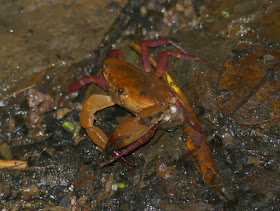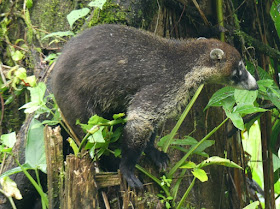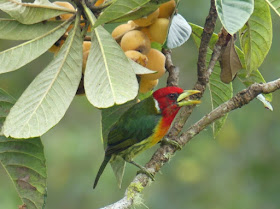Last time I introduced you to Costa Rica, a truly remarkable little country in Central America, at the very southern tip of North America. After looking at some key habitats we met some of the country's wonderful bird life. Today, as promised, I'm going to offer centre stage to some of the other superb fauna that we encountered - and as I also mentioned, we were only there for a short time, doing the preparation for a return trip in 2020.
It's traditional to start such a tour of 'other animals' with mammals (showing our bias) - so I'm going to start with frogs, of which Costa Rica boasts some 140 species. We saw some truly superb frogs, especially on a night walk in the rain with brilliant but self-effacing local guide Jaime, in the private reserve called Tapirus Lodge (the name celebrates the tapir genus name) in the montane rainforest alongside Braulio Carillo National Park not far north-east of San José. Jaime's ability to locate and pluck frogs and small snakes seemingly at will from the forest (and return them later) was miraculous.
 |
| Red-eyed Tree Frogs Agalychnis callidryas are spectacular and abundant, though this photo doesn't do it justice. I'll try and do better next time! |
Not all frogs require splashing through the night forest however (though that's not a pleasure to be foregone). The exquisite poison arrow frogs (family Dendrobatidae) are active in the daytime. Despite the name only four of the 170 species are apparently known to be harvested for their toxins by indigenous Neotropical people.
 |
| Green and Black Poison Dart Frog Dendrobates auratus, also at La Selva (or rather just outside it, in a cocoa plantation). The porcelain-like texture of these little frogs is astonishing. |
Reptiles are even more diverse - some 220 species of them. One that we came across more than once, from the rainforest floor to the canopy, is the small but deadly little Eyelash Pit Viper Bothriechis schlegelii. It does not of course have eyelashes, but fine scales above the eyes. The pit vipers are a relatively modern family of venomous snakes from Asia and the Americas - too modern to have found their way to Australia. This species varies greatly in colour.
 |
| High in the canopy at Monteverde, in the central mountains (seen from a suspension bridge high above a gully). They are only active at night; this one's head can just been seen in the coils. |
 | |
| This one, low in shrubbery at Tapirus Lodge, became active at night - the 'eyelashes' are clearly visible here. |
Another viper is much bigger, sometimes up to two metres long, though not typically. Fer-de-lance is a name used for several species of the mostly terrestrial genus Bothrops (including B. asper in Costa Rica), though some would say this should only be used for B. lanceolatus from Martinique. They are dangerously venomous, though not usually active in the day.
 |
| Common Snaileater Sibon nebulatus, Tapirus Lodge. |
Costa Rica has twice as many snake species (140) as lizards, though the latter, being mostly diurnal, are much more conspicuous. The small quick anoles are seemingly everywhere, and many are not readily identified (at least by me!). Here is a representative of them!
 |
| Unidentified anole, Carara National Park. They are variously placed in the iguana family, or given their own, Dactyloidae. |
 |
| Big Spiny-tailed Iguanas Ctenosaura similis run the carpark at Carara NP. |
This one is limited to Central America and Mexico, while the more familiar Green Iguana Iguana iguana is found from Mexico and the Caribbean to southern Brazil.
 |
| Green Iguana in a street tree, San Isidro. (This one was actually in the same tree as the exquisite Turquoise Cotinga that I featured last time.) |
 |
| Green Spiny Lizard Sceloporus malachiticus, Family Phrynosomatidae, at a chilly 3400 metres above sea level in the central mountains. |
 |
| The Green Basilisk Basiliscus plumifrons, Family Corytophanidae, here in a private reserve at La Fortuna, also in the central mountains, is seemingly almost literally fabulous. |
My small offering of invertebrates does not indicate disrespect, but simply my inability to go close to identifying them. Let's just enjoy them.
 |
| Butterfly, Cerro Lodge, on the Pacific coast near to Carara NP. |
 |
| Grasshopper, La Selva Biological Research Station. |
 |
| Moth (and an amazing one!), Tapirus Lodge. |
 |
| Land Crab, Monteverde. Not what I expected to encounter on a mountain forest track, even in the rain! |
And so to the mammals, who've been waiting their turn patiently.
There are only four species of monkey in Costa Rica, of which only Mantled Howlers Alouatta palliata are widespread and readily seen.
 |
| Mantled Howler female and baby, high above the ground in the canopy below a suspension bridge at Monteverde. |
 |
| Variegated Squirrels Sciurus variegatoides are strikingly handsome with an array of coat colours, though the grizzled tail is fairly constant. Widespread but not usually in mature rainforest. |
And finally, the only mammal presented here whose ancestors actually arose in South America - the others either came from the north (coatis and tapirs) or crossed the Atlantic from Africa long ago (monkeys and squirrel).
And that's it for today; again I hope you've found this little series of interest. If not, rest assured that the fault is mine, not that of the wonderful little land of Costa Rica.
NEXT POSTING THURSDAY 10 OCTOBER
(And remember that you can get a reminder when the next post appears by putting your email address in the Follow by Email box in the top right of this screen.
And I'd love to receive your comments - it's easy and you don't need to sign in!)
(And remember that you can get a reminder when the next post appears by putting your email address in the Follow by Email box in the top right of this screen.
And I'd love to receive your comments - it's easy and you don't need to sign in!)






























